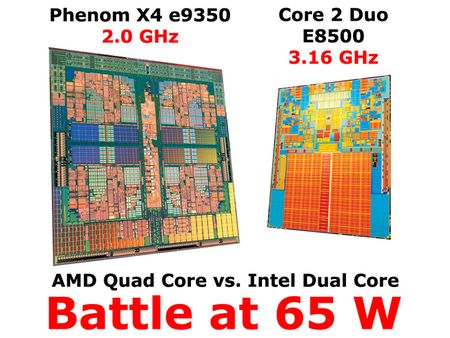Dual-Core Versus Quad-Core: Part 2
Can Intel’s Dual Core Beat AMD’s Quad?
This is a comparison that will probably get your emotions running high, as it represents a shootout between apples and oranges. But it is also a comparison that is extremely relevant, as it reflects the current market and answers very important questions about the current offerings from AMD and Intel. We decided to put AMD’s most efficient quad core processor up against one of the fastest Intel dual core CPUs: it’s the AMD Phenom X4 9350e 2.0 GHz against Intel’s Core 2 Duo E8500 at 3.16 GHz.
Although it doesn’t seem appropriate to compare a 3.16 GHz dual core processor to a 2.0 GHz quad core model—especially since the first one is made by Intel and the second is from AMD—this comparison makes a lot of sense. Performance-wise, the Phenom X4 clearly has the potential to leave the Core 2 Duo in the dust, but we wanted to check whether or not this applies in everyday life with real applications, and to see if the Phenom can keep up in the area of efficiency. As it turns out, these two products have a lot more in common than you might think.

Different Architectures and Efficiency
Let’s first talk about where the products are dissimilar, starting with their architectures, which could not be more different. AMD utilizes its optimized 65 nm DSL SOI process, while Intel has been at 45 nm for a while. AMD integrated the DDR2 memory controller and uses Socket AM2+ (940 pins), while Intel relies on Socket LGA775 and the chipset for memory performance, using either DDR2 or DDR3 RAM. AMD offers a third-level cache (L3) that is shared by all processing cores, but it also offers a dedicated L2 cache. Intel, on the other side, shares the L2 cache between both cores, and offers larger cache capacity (6 MB L2 for Intel vs. 4x 512 KB L2 and 2 MB L3 cache for AMD). As verified by test results, the 65 nm AMD quad core seems to be handicapped when it comes to efficiency, but we’ll look at that in detail later on.
Same Thermal Design Power
Despite their entirely different construction, the AMD Phenom X4 9350e and the Intel Core 2 Duo E8500 are both rated at a maximum thermal design power (TDP) of 65 W. This means that they’re both suitable for desktops and HTPCs that you don’t want to equip with sophisticated cooling for reliable operation. Reaching the 65 W TDP is not difficult for Intel using its efficient 45 nm process (P1266), but it certainly requires a selection process for AMD, as the 4-core Phenom X4 series isn’t as efficient as the 45 nm Core 2 series. The selected model e9530 is a low-power Phenom X4 variant, though.
Same Performance?
Get Tom's Hardware's best news and in-depth reviews, straight to your inbox.
We’ll answer this question in the benchmark section, but the shootout will be exciting. Additional cores typically don’t scale anywhere near to linearly, meaning that going from two to four cores will not result in doubled computing performance, unless your applications are really thread-optimized and are not bottlenecked by other system components. While AMD’s Phenom X4 at 2.0 GHz provides great performance for multi-core optimized applications, the Core 2 Duo by Intel delivers more performance per clock, and also comes with a 58% faster core clock speed of 3.16 GHz, which should bridge the performance gap on thread-optimized applications.
Same $200 Price Point
For me, this was the key point for running this article: AMD’s most efficient quad core costs the same as Intel’s speedy dual core processor. The price point of $200 is probably the maximum amount of money an average user without particularly deep pockets is willing to spend, considering that prices will keep dropping. Shelling out more on a processor is only worthwhile if you have specific applications that require more performance. The Core 2 Duo should provide better power efficiency, while the Phenom X4 may very well outperform the Core 2 in many applications. We wanted to have answers, so we got to work.